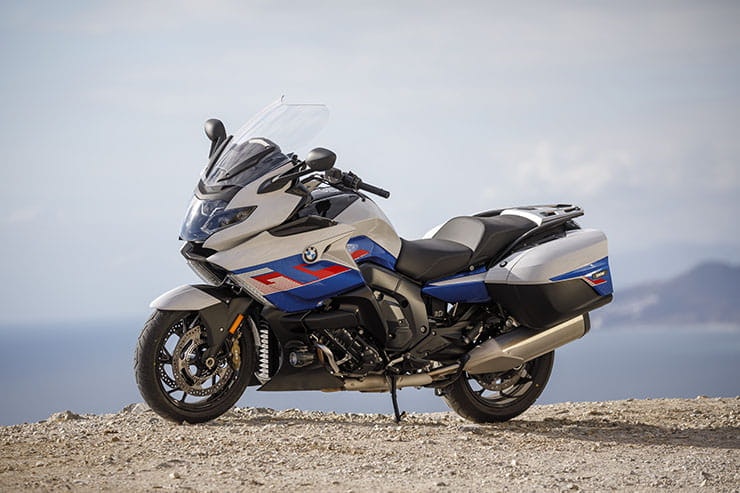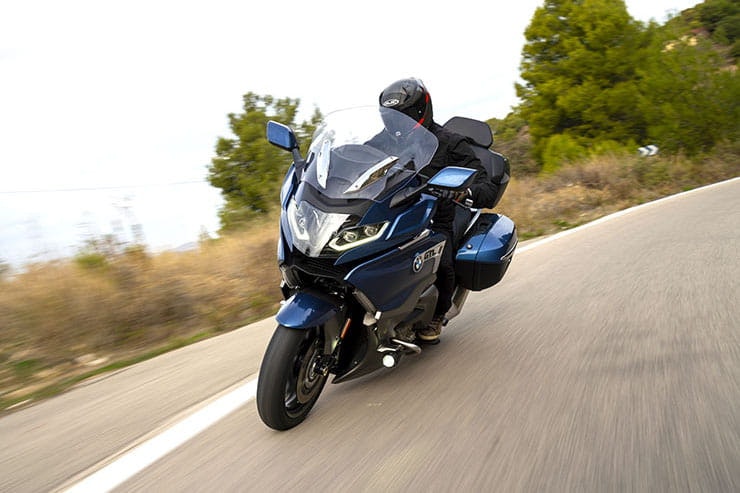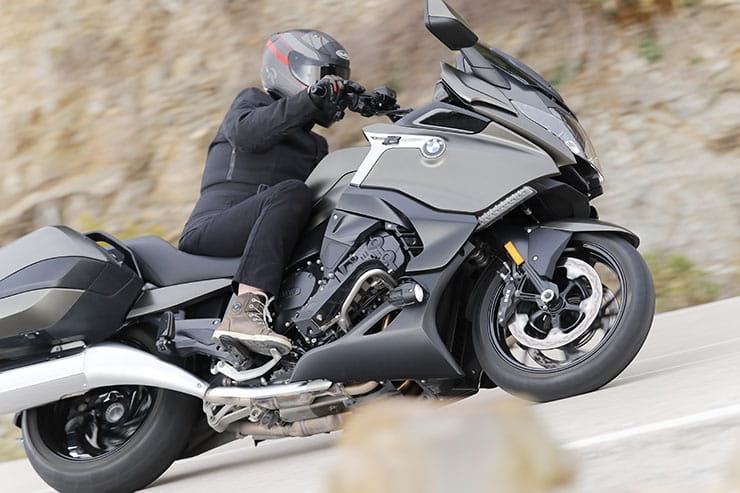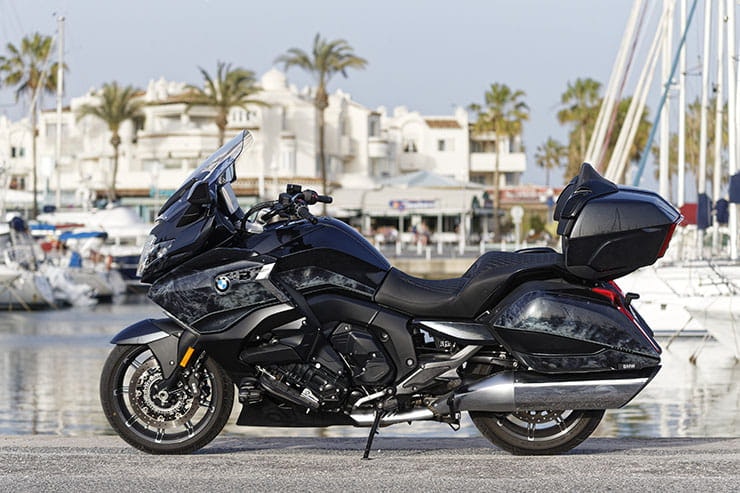BMW K 1600 GT, GTL, Bagger and Grand America (2022) - Review
BikeSocial Road Tester
24.02.2022
Kit Credits
Helmet
HJC R-PHA 11 - Nakri Carbon Red - £375 | www.sportsbikeshop.co.uk
Jacket
Tucano Urbano Gulliver 2G - £250 | www.sportsbikeshop.co.uk
Boots
Stylmartin Marshall WP boots - £155 | www.sportsbikeshop.co.uk
2022 BMW K1600: What’s the big news?
BMW’s K1600 series of luxury, high-performance grand tourers is updated for 2022 with Euro5 compliance, more torque, a new dash, self-levelling preload, a back-torque limiter and a handful of electronics and functionality tweaks.
It’s not a huge list of refinements and the 2022 range of K1600s – the standard GT, full-dress touring GTL, US-style Bagger and US touring Grand America, all sharing the same engine and chassis platform – clearly aren’t a ground-up overhaul. BMW haven’t re-invented the K1600s, or even developed them very much from last year’s bikes.
So, do the changes significantly improve one of the world’s most extreme grand tourers? And can they keep the K1600 relevant in 2022? Or is this the last update before the K1600 series joins the dinosaurs in the where-are-they-now file?
BikeSocial is at the launch in Malaga, Spain, to find out.
Engine – unique, effortless turbine-like power from the world’s only inline six
Handling – superb steering agility and dynamic handling for a big lump
It still exists – kudos to BMW for keeping such an absurd bike alive in 2022
No quickshifter as standard – come on BMW, a £450 accessory is a bit rich on a flagship
No adaptive cruise control – another odd omission for a revised premium tourer
Existential guilt – wringing hands over the wanton excess of six-cylinder mega-bike and wondering, as the planet dies a little, ‘What’s the point of it?’
2022 BMW K1600 series prices and availability
The K1600 series will be in showrooms from early March 2022. The base prices and broad differences between the models are as follows:
K1600 GT: £20,395
K1600 GTL: £21,920 – adds a stereo, a top box and more relaxed ergonomics (lower seat, bars closer to rider)
K1600 Bagger: £20,215 – US-style slash-cut back end and exhausts, even more relaxed riding position
K1600 Grand America: £24,410 – same as Bagger but with almost every optional extra fitted
That sounds like a lot of money and it *is* a lot of money – but when the K1600 was launched in 2011 the base model was £15,075, or £19,550 in today’s money – so the new bike is around a thousand pounds more expensive, relatively speaking. But now you get semi-active suspension, a flash dash, some features as standard that were once extra (like heated grips and seat) and some that weren’t originally available (like reverse gear). So, arguably, the K1600 is at least equivalent value today as it was in 2011.
For context, BMW sold 128 K1600s in the UK in the first three quarters of 2021 – predominantly the K1600 GT followed by the GTL.
2022 BMW K1600 GT PCP info
BMW K1600 GTL PCP info
BMW K1600 Bagger PCP info
BMW K1600 Grand America PCP info
2022 BMW K1600 series spec and trim packages
The K1600 engine and chassis package is the same across all models, but trim level specs vary and add to base prices. The full menu of the accessories available for each bike is substantial, so here’s a breakdown:
All 2022 K1600 models come with:
10.25in TFT dash
dynamic ESA semi-active with self-levelling preload
traction control and rider modes
engine braking control
hill hold control
heated seats and grips.
reverse gear
phone compartment with USB charge port
LED auto-adjust headlight (cornering and up/down according to preload)
custom ‘favourite’ buttons
tyre pressure monitors
cruise control
2 x 12v sockets
2022 BMW K1600 Power and torque
Peak power: 160.5bhp at 6750rpm
Peak torque: 133 lb.ft at 5250rpm
The 2022 K1600 makes the same peak power figure as last year’s bike, and slightly more torque – but peak power is 1000rpm lower in the rev range at 6750rpm. Pushing power lower in the revs sounds like the kind of change manufacturers normally make when adapting an engine to meet Euro5 emissions regs – and that’s exactly what BMW have done with the 2022 K1600.
But BMW also say the K1600 engine changes to achieve Euro5 aren’t mechanical; they’ve met emissions targets purely by adding more sensors – two knock sensors on the rear of the block and an extra two wideband lambda sensors downstream of the catalysts – to better monitor and manage the engine’s combustion (fuelling and ignition timing) with greater fidelity. As a result, BMW say they haven’t needed to alter the K1600’s cam timing or modify its intake or exhaust system.
And so with 160.5bhp and 133 lb.ft, the K1600 is still abundantly potent in the go-motion department. In grand-touring GTL spec, with stereo and top box, it’s pretty much the world’s most powerful and torquiest fully featured grand tourer. But that’s a narrow field of rivals: apart from Honda’s Gold Wing and BMW’s own R1250 RT, there’s not a lot of competition. The Wing is the K1600 GTL’s most obvious rival: also a six-cylinder (a flat six; three pairs of opposed pistons) and 200cc larger – but with 125bhp and 125 lb.ft, it’s a lot less motor than the BMW.
The base K1600 GT – panniers only, no stereo – has a slightly tougher job convincing the world of its engine heft because it’s arguably in a similar hypersports tourer class to machines like Kawasaki’s H2 SX SE and Suzuki’s Hayabusa – both with more impressive 180bhp+ dyno specs, and both sharper, sportier and less massive – but also less luxurious than the K1600 (they don’t have a stereo option), and neither of them have an inline six-cylinder engine.
2022 BMW K1600 Engine, gearbox and exhaust
The K1600’s 1649cc inline six-cylinder is the only straight six in motorcycle production, as it was when it debuted in 2011. But BMW know a thing or two about building inline sixes from their automotive experience, and some of the original K1600 design team’s understanding of crank stresses were carried over from the car division (an inline six has a comparatively long crank, and more prone to flex than a shorter inline four crank).
Another original K1600 engine design consideration was managing its width – an inline six isn’t a naturally narrow configuration. BMW skirted the girth issue by using a long stroke and narrow bore architecture (relative to the K1300 inline four series) – keeping the bores narrow meant the engine was only 122mm wider than the K1300, but also contributed to the motor’s peak power output at a modest rev ceiling (amusingly, in the press blurb for the new K1600 BMW says the engine is, “...still the narrowest six-cylinder inline engine in motorbike series production...”, which, as the *only* six-cylinder inline engine in motorbike series production, it would be).
But in most other respects the K1600 engine is fairly conventional – it just has more cylinders than most.
And all that’s been known since the bike was launched in 2011. Right here and now, in Malaga’s warmer (if not drier) February climes, the 2022 K1600 feels as uncannily smooth and as inordinately blessed with torrents of performance as before – and now even more readily accessible from lower revs. Opening the throttle unleashes a rolling wave of acceleration, delivered with an unconventional flavour. The engine is in perfect primary and secondary balance, which means an absence of normal vibration (apart from what feels like some torsional or combustion vibration – it isn’t quite as smooth as an electric motor).
But this smoothness is also slightly lacking in classic internal combustion engine charisma – it’s missing the normal to-and-fro of reciprocating masses thumping around down below.
Bike engines generally either thump (singles, twins), scream (inline fours) or do a bit of both (inline triples, V4s, crossplane inline fours, flat sixes). What they tend not to do is whirr seamlessly the way the K1600 does – which is why it’s hard to get a firm grip on the BMW’s character in relation to any other bike (with the exception of previous inline sixes, like Honda’s CBX, Kawasaki’s Z1300 and Benelli’s 750/900 Sei). The engine feels as if it fell from outer space and happened to land between a pair of motorcycle wheels. It could equally have landed in a car’s engine bay.
The K1600 sounds unlike any other bike too – pin the throttle and while you’re pressed firmly back into the seat under some incredible acceleration (that’s a lot of mass to hurl down the road), its muted induction roar has a distinctly car-style throatiness. Maybe it’s because the K1600’s cylinders are fed by a single throttle valve, feeding into a common plenum chamber shared between all six intakes. It’s an unusual design, more familiar in the car world than on motorcycle engines.
The original K1600 had a hell of a chunky gearbox; big clonks and lots of drivetrain lash down the shaft. BMW have refined the transmission over the years since 2011, but there’s still a hint of ker-plunk when the lever slots the next cog home. The up/down quickshifter is BMW’s usual painless experience; a fairly leisurely ignition cut, slick and reliable – but there’s a sense it’s very much useful for smoothing out the shift. Somewhat amazingly, the quickshifter isn’t standard fitment and you’ll have to fork out £450 for the privilege of an accessory that bikes costing half as much as the K1600 get as oe fitment. That’s a bit of a cheek.
One extra for 2022 that does come included in the price is a new back-torque limiting system – the electronic equivalent of a slipper clutch. It’s not new tech, just new to the K1600: when the IMU detects a differential between wheel speeds under braking, in other words the rear wheel starting to lock up when downshifting rapidly, it opens the throttle valve momentarily, releasing engine braking and preventing the rear wheel from locking up and hopping. A revised 6-axis IMU also takes lean angle into account, so the control is modulated according to cornering position.
2022 BMW K1600 Economy
BMW claim 5.9 litres per 100km, or 47.9mpg which, with a 26.5 litre tank would give a full-to-empty range of 279 miles. Take off four litres for reserve, and you should be looking at 240-odd miles until the fuel light comes on.
On the launch, riding spiritedly but not brain-out in some mixed weather, the K1600 GTL was recording 7.5 litres per 100km, or 37.7mpg, giving a very different 220 miles to empty and just over 180 miles to reserve.
BMW claim the same fuel consumption figures for all four K1600s, from the GT to the Bagger to the GTL to the Grand America – because they’re measuring the engine’s consumption on a test bed, and presumably not in real world riding. Which is at least one reason why the claimed figure is so different from that actually achieved. It’s fair to say that over 200 miles is easily achievable with sensible throttle use – but then, why have six cylinders if you’re going to be sensible?
2022 K1600 Handling, suspension, chassis and weight
Like its engine spec, the K1600’s chassis spec is common across all four models, differing only in weight and rear suspension travel – the low-slung Bagger and Grand America have 10mm less travel at the rear. The claimed kerb weights for the bikes are: GT is 343kg, the GTL is 358kg, the Bagger is 344kg and the Grand America weighs in at 370kg. For reference, a Gold Wing with DCT is 367kg.
Handling on all four bikes is superb. As the last remaining BMW to run Duolever forked front suspension – BMW’s own rival to the Telelever wishbone system on their GS and RT – the K1600 tracks with an unexpected and welcome lightness of touch at the bars, steering with the agility of a bike half its weight. In fact there are a couple of sports tourers than won’t turn as sweetly as a K1600. Alpine hairpins on a K1600 will be less work at the bars than your average Kawasaki Z1000SX.
The big theoretical advantage of Duolever (basically a system of scissor linkages and a big swingarm hanging from the steering head) is that it separates steering, braking and suspension forces from each other. This means the feeling at the bars – the weight of the steering – doesn’t load up under braking; which is a big help trail braking mid-corner without the bike trying to run wide or steer out of the turn. And it feels perfectly natural, like a pair of forks, too – there’s no acclimatisation or unfamiliar feeling from the front end.
The K1600’s semi-active suspension and auto-levelling preload does a good job of pinning wheels to the road under most riding conditions; in Dynamic mode, bumps and imperfections are fed back to the rider and it’s always easy to tell what the wheels are up to; in Road mode things soften off but the bike never gets wallowy unless you’re really hamming it up. Like the Gold Wing, with its own, similar, double wishbone front suspension system, really big potholes can deliver a big thump you feel through the chassis (not the steering) – the rigid front swingarm has little innate large force damping you get from flex in conventional forks (and you wouldn’t want to find out what the system is like at absorbing bumps at 55° of lean). But on a bike like the K1600, it fits perfectly.
2022 BMW K1600 Brakes
Perhaps the most conventional part of the K1600 series are its brakes: non-radial, 4-pot calipers on 320mm discs, with accompanying ABS support. They work well, hauling up even the steamboat fatty K1600 Grand America with unstressful haste.
We didn’t have the opportunity to ride the K1600s in the dark, but BMW say the previously swivelling headlight (to help see round corners) now also pivots up and down automatically according to pitch data from the 6-axis IMU – not only does this mean it self-levels according to the preload setting (so when your passenger jumps on board the headlight adjusts itself), it also means the headlight will maintain position when the bike is under acceleration or braking. As anyone who finds themselves riding at night on unfamiliar mountain roads, this could be a big Brucie Bonus.
2022 BMW K1600 Comfort over distance and touring
We finally come to an area that separates the K1600 series – ergonomics. One at a time: the GT is a conventional ‘sit-on’ riding position – still a pretty relaxed position, but noticeably more engaging and dynamic than the GTL with its lower seat height, more set-back bars and a very ‘sit-in’ feeling.
Of the two, the GTL is the more instantly classic ‘touring’ position, but remember this is in comparison – jump on the GT in isolation in a showroom and it’ll feel plenty touring. The seat construction is the contributor to the difference in seat heights: the GT is 810mm as standard with an adjustment to 830mm and a low seat option of 780mm, while the GTL is 750mm as standard with an option of 800mm (there’s no adjustment on the GTL).
But the GT’s seat is much more padded than the GTL’s – and that’s not necessarily a good thing; I wasn’t able to put many miles on the GT but the seat felt spongy; I preferred the flatter, firmer feel of the GTL. Having said that, the tops of my quadriceps were killing me after the test ride (most of which was on the GTL) so they must have been doing something while I was riding.
The Bagger and Grand America, in keeping with their long, low, US-style styling, share the same 750mm seat height. The Bagger has a plain one-piece seat, the Grand America gets a more detailed perch. Both bikes come with raked-back one-piece handlebars and the option for footboards, which might make sense cruising on the freeway but not having neither a brake nor gear lever nearby feels disconcerting anywhere else.
All four K1600s share enviable wind protection. The standard electric screen (available in alternate sporty size) covers a wide range of adjustment and, fully upright, isolates the rider from wind (and noise) entirely – and all bikes feature flip-out air deflectors to direct cool air towards the rider. You could ride the K1600 a very long way without getting your hair ruffled.
2022 BMW K1600 Rider aids and extra equipment/accessories
The K1600s come armed with a wealth of rider aids and gadgets as standard. Starting at the front, we’ve already covered the swivelling headlamps and adjustable screen, so the next major item staring us in the face is the 10.25in TFT dash, as found on the new R1250 RT. It’s massive, bright, crisp, visible in all lights and capable of displaying BMW’s proprietary sat nav system on one side of the screen (connected via a self-locking smartphone compartment above the dash with USB port and even a cooling fan to keep the phone cool).
Personally, I prefer the K1600’s old dash layout with twin dials and smaller info screens, and a clip-in sat nav space above them – for me, scanning 10.25in of dash real estate while riding isn’t problematic but it isn’t very elegant either; manufacturers can make the TFT screen look as Carlos Fandango as they like with graphics and lights when they’re powered up, but ultimately they’re a slab of plastic. Maybe a bit of chrome trim would help. Or making it look like something Apple might make.
Switchgear is BMW’s standard jog wheel system, and it’s relatively intuitive and easy to access menus and trip info. New for 2022, BMW have added four ‘favourite’ buttons on the left inner fairing panel, which can be set-up for any of 18 different functions. So you can have, say, the heated grip menu on one, allowing instant adjustment rather than having to make multiple button presses to locate the correct menu on the clocks. It’s a nifty and convenient idea.
Switching between riding modes is still a simple button press – and the K1600s all come with BMW’s full suite of traction control and riding mode options, all integrated with semi-active suspension and the new self-levelling preload.
The uprated sound system has some new features (standard on the GTL and Grand America, optional on the GT and Bagger) – the aerial is now hidden, and using DAB radio is now an option, with auto-switching between FM and DAB for the best signal. The EQ section has been uprated too, with the option to switch between optimised settings for riding and standstill.
But for me, the idea of an on-board stereo has worn a bit thin – it was an exciting novelty in the 1980s on Honda’s Gold Wings, but since the advent of Bluetooth intercoms and excellent in-ear canal phones or helmet speakers, having a pair of outboard speakers blaring your appalling taste in music to the world at large feels anachronistic. And you still can’t hear it very well above 80mph with a closed visor and ear plugs, so I’m not sure what the point is. Maybe our Americanist friends like that kind of thing. Maybe Germans do.
Other goodies available on the K1600 include optional ground lighting, to illuminate the floor below the bike at standstill, letting you see where you’re putting your feet (and the side stand) down at night. Nice, but of limited use. The reverse gear is a lot more convenient for backing the bike into parking spaces.
2022 BMW K1600 Styling and verdict
Highly subjective, but I think the K1600 is a good-looking beast, especially in red/white/blue motorsports colours – an extra £520. But the ‘cloudy’ Option 719 Meteoric Dust scheme is crass and the Mineral White scheme with chrome highlights and brown seating is spectacularly tasteless. You just wouldn’t, would you? The Bagger has a neater rear end; with the brake lights incorporated in the panniers looks a neater solution than the GT’s conventional rear brake light cluster.
Perhaps the biggest styling issue with the K1600 has always been you can’t easily see it’s an inline six. Maybe that’s why BMW pop a big ‘6’ numeral on the side of the barrels – but back in the day half the point of Honda’s CBX1000 was impressing passers-by with the size of your engine (I well remember excitedly counting the exhaust headers as a 10-year-old). At the launch in 2011 I asked the BMW bosses if they had plans for a naked K1600R, along the lines of the then current K1300R. They umm-ed and ahh-ed and said they hadn’t considered it.
And it’s too late in the game to do it now – this is probably the K1600’s last hurrah. Although BMW should be applauded for converting the K1600 to Euro5 compliance and giving us another chance to experience its extravagance, it can’t help but feel as if the days of this kind of high-performance gas-guzzling excess are numbered. The fact BMW haven’t seen fit to equip the bike with the latest de rigueur gadget – adaptive cruise control – plus the slightly afterthought nature of the launch itself (BMW tagged the bike launch onto the end of a new car launch and initially didn’t book a videographer to record it) suggests BMW Motorrad have their corporate attention elsewhere. They didn’t even bother to find new tyres for the bikes – the GT and GTL were on Bridgestone T30s, which is nearly a 10-year-old tyre design.
An inline six might be the closest a reciprocating internal combustion engine gets to feeling like an electric motor – but in less than 15 years’ time, that’s probably what it will be.
2022 BMW K1600 spec
2022 BMW K1600 Trim and accessory price matrix
Most options are available as packages (Comfort Package or Touring Package) or as individual items. The Comfort Package includes up/down quickshifter, central locking and keyless ignition for £1120, and the Touring Package includes engine bars, fog lights and an audio system for £1600.
In the UK, three of the four models also come in SE or LE versions. The K1600 GT SE is a GT with the Comfort package, the GTL SE is the GTL with the Comfort Package, the Bagger LE is a Bagger with the Touring Package and the Grand America has everything on it already so it’s pre-loaded.
And if all those choices aren’t enough, BMW’s Option 719 series of accessories offers even further customisation possibilities. Remember the days when the only new-bike buying decision was which colour you wanted?
What is MCIA Secured?
MCIA Secured gives bike buyers the chance to see just how much work a manufacturer has put into making their new investment as resistant to theft as possible.
As we all know, the more security you use, the less chance there is of your bike being stolen. In fact, based on research by Bennetts, using a disc lock makes your machine three times less likely to be stolen, while heavy duty kit can make it less likely to be stolen than a car. For reviews of the best security products, click here.
MCIA Secured gives motorcycles a rating out of five stars, based on the following being fitted to a new bike as standard:
A steering lock that meets the UNECE 62 standard
An ignition immobiliser system
A vehicle marking system
An alarm system
A vehicle tracking system with subscription
The higher the star rating, the better the security, so always ask your dealer what rating your bike has, and compare it to other machines on your shortlist.



